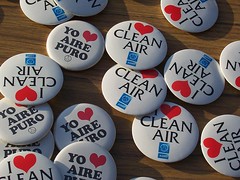Cleaning the air with smart growth

Posted September 16, 2010 at 12:55PM
This week marks the 40th anniversary of the federal Clean Air Act, providing an appropriate occasion to revisit the effects of sprawl and smart growth on air quality.
As noted in a report on public health and smart growth prepared by Lawrence Frank, Sarah Kavage and Todd Litman, the increased automobile trips and miles driven under sprawling land use patterns are “associated with higher levels of several air pollutants that have adverse respiratory health impacts. These harmful pollutants include fine particulates, toxins, carbon monoxide, NOx [nitrogen oxides] and VOCs [volatile organic compounds.” (NOx and VOCs are precursors to ozone smog.)
Things you would rather not breathe, those. The pollutants, which have varying individual characteristics that are detailed in the report, collectively cause or significantly contribute to shortness of breath, asthma, bronchitis, heart attacks and death.
Smart growth helps:
“In general, anything that reduces per capita motor vehicle travel (particularly short, cold engine start trips), makes vehicle traffic smoother, favours less polluting vehicles (such as alternative fuels), and increases the physical separation between vehicle traffic and people is likely to reduce vehicle pollutant human health risks. As population density increases, so do the benefits of these interventions.
“Short motor vehicle trips in urban conditions tend to have relatively high per-kilometre pollution emission rates due to cold engine starts and congestion, so reductions in such trips tend to provide relatively large emission reductions. [Note: pollution peaks during engine warm-up after cold starts, and rises again with evaporation after shut-off, so reducing the number of starts and shut-offs is important to reducing harmful air emissions.]
“These short trips are also the same trips most likely to be replaced by walking and cycling trips if land use patterns become more walkable. However, increased land use mix, density, and street connectivity is associated with reduced per capita levels of volatile organic compounds and oxides of nitrogen which react in sunlight and form harmful ozone (Frank et al 2000).
“Moreover, benefits from reduced distances traveled associated with increased proximity between destinations overwhelmed the effect of increased levels of pollution from cold starts.”
The authors go on to report that research in the Seattle region indicates that each 25 percent increase in walkability is associated with a 5.6 percent reduction in NOx emissions and a 5.5 percent reduction in emissions of VOCs, due to reduction in vehicle trips These conclusions are consistent with those reached by Reid Ewing and Robert Cervero in their exhaustive “meta-analysis” of literature on travel and the built environment.
The authors correctly point out, however, that traffic concentrations in dense neighborhoods can also result in higher exposure to particulates, which should be mitigated. (Historically, particulate emissions are a greater problem with respect to the diesel engines used by heavy vehicles such as trucks and buses than with respect to gasoline engines.) From the report:
“In conjunction with more compact development, however, policymakers should encourage alternative fuels and engine technologies, especially in commercial fleets and transit vehicles.
“Core areas should be buffered from the movement of goods. Housing facilities for at-risk populations, such as the elderly and people with respiratory illnesses, should be located in places where particulates are less concentrated.”
The good news on that front is that today’s diesel technology is far cleaner than diesel used to be, and many transit and commercial fleets have switched to compressed natural gas and diesel hybrid technology, which in some cases is cleaner still.
Moreover, in a study of the effects of infill development [building on vacant or underutilized tracts of land amidst other development] on air pollution published in 2007, the federal Environmental Protection Agency concluded that “strong support for infill development can be one of the most effective transportation and emission reduction investments regions can pursue.” (I reviewed the report here.) Examining three metropolitan regions in detail, the EPA researchers found the following:
- “Over time, shifting 8 percent of Denver’s jobs and households toward 10 regional centers reduced congestion by 6 percent and emissions by 4 percent. This is equivalent to removing nearly half a million trips per day from the region’s roads, a significant share of the daily average.
- “The Charlotte scenario evaluated infill development along the South Corridor light-rail stations. It concluded that although new rail service by itself would reduce congestion in the corridor, redirecting 16,000 households and 10,000 jobs to station areas would produce 10 times more emission reductions and increase transit ridership by more than 6,000 trips each day.
- “In Boston, the analysis considered redevelopment of brownfield sites in 13 suburban towns along the I-495 corridor. Redirecting new development to these town centers reduced vehicle travel by 154,000 miles per day during the evening rush hour. This reduction was equivalent to eliminating more than 10,000 trips, similar to the additional traffic accommodated by multi-million dollar road-widening projects proposed for these towns.”
The iconic Atlantic Station brownfield redevelopment in Atlanta is perhaps the poster child for reducing air pollution through smart growth. Indeed, the 138-acre project, currently host to some 3000 residents and 3500 jobs, could never have been built if EPA hadn’t been convinced that it would produce air quality benefits. This is because the project required a construction permit for a new bridge over a freeway complex to provide access to the rest of midtown Atlanta.  At the time the project was proposed, the region was in violation of EPA "conformity" rules for coordinating air and transportation planning, with the result that additional transportation facilities were not allowed.
At the time the project was proposed, the region was in violation of EPA "conformity" rules for coordinating air and transportation planning, with the result that additional transportation facilities were not allowed.
EPA was convinced that the project would reduce air emissions compared to other sites that did not require the new bridge, and granted a special exemption from the construction ban. Atlantic Station today is one of the most successful new mixed-use developments in the world, and the forecast has been proven correct: according to data from 2008, Atlantic Station residents travel an average of 14 vehicle miles per day, and employees working at Atlantic Station travel 12 miles per day, far below the regional average of about 34 miles per day. (The forecast for residents was 25 miles per day, so the built development beat not only the average but the prediction, and substantially.) Accordingly, air emissions are also substantially lower per capita than with average development. In addition, only about half the trips made by residents and employees are in single-occupancy vehicles, below the regional average of more than 60 percent.
This paragraph added 11.25am ET:
Finally, just today Sonal Patel, MD and board member of the American Lung Association in California, summarized the health benefits of smart growth - including those related to cleaner air - in Capitol Weekly:
"The American Lung Association in California has developed new data on the health benefits of smart growth scenarios for California. The results show that by 2035, more compact development patterns could result in 45,000 - 104,000 fewer asthma attacks and other respiratory symptoms and 61 - 141 fewer premature deaths each year from reduced vehicle emissions. These health benefits add up to $700 million – $1.7 billion annually in avoided public health costs. These numbers are conservative and would be higher if they included the additional major benefits of increased physical activity."
This evidence is strong, in my opinion. While the benefits of smart land use are many, and are multiple even within the field of human health, there is little more fundamental than the air we breathe. Smart growth helps clean it. We didn’t know that when the Clean Air Act first appeared four decades ago, and even today the regulatory structure surrounding air emissions struggles to keep up with what we have learned with regard to the built environment and travel behavior. Now that the evidence is mainstream, we can and should incorporate smart growth strategies into regions’ clean air plans and take steps to ensure that policy reflects those benefits. Regulators have made some progress on that front in recent years, and let’s keep moving in the right direction.
Move your cursor over the images for credit information.


